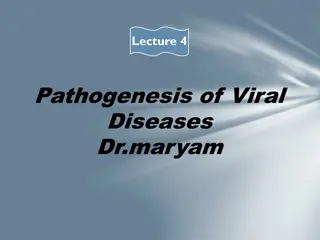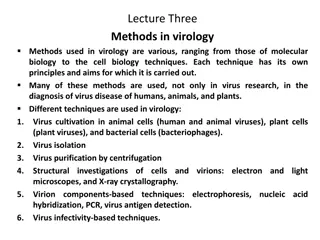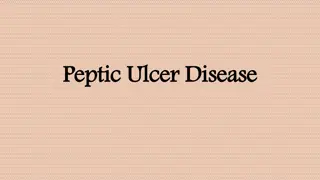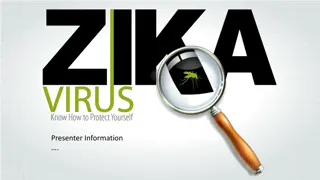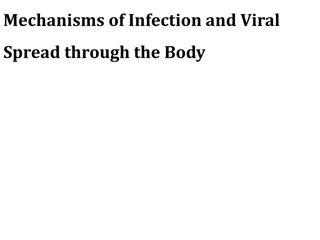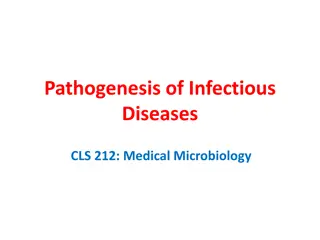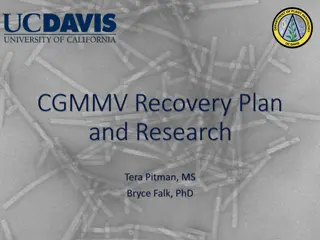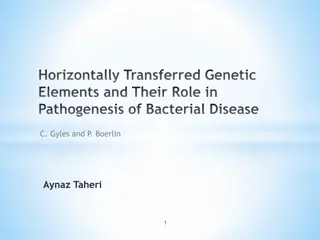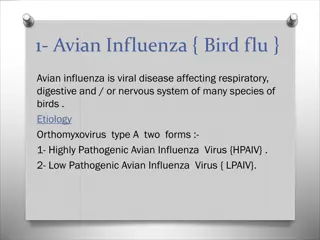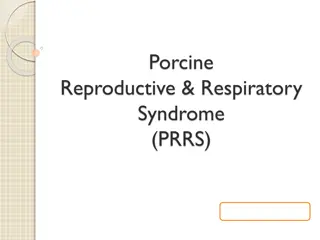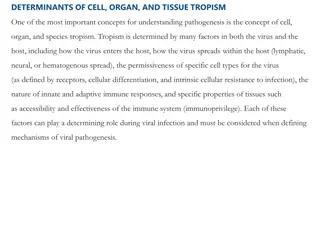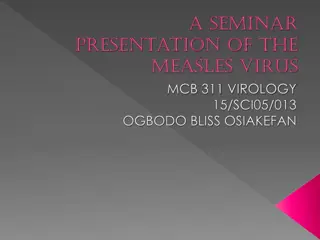Virus Entry Mechanisms: Understanding Pathogenesis and Spread
Exploring the diverse ways viruses enter the body through various routes such as respiratory tract, oropharynx, skin, genitourinary tract, and eyes, shedding light on the steps of the virus life cycle shaping pathogenesis. Viral diseases result from the intricate interaction between viral and host factors, leading to disease production and proliferation of harmful viruses within the body. Understanding these mechanisms is crucial for preventing and controlling viral infections.
Download Presentation

Please find below an Image/Link to download the presentation.
The content on the website is provided AS IS for your information and personal use only. It may not be sold, licensed, or shared on other websites without obtaining consent from the author. Download presentation by click this link. If you encounter any issues during the download, it is possible that the publisher has removed the file from their server.
E N D
Presentation Transcript
Mechanisms of Infection and pathogenesis
Viral disease :proliferation of a harmful virus inside the body and cause disease. Viral pathogenesis interaction of viral and host factors that leads to disease production
steps of a virus life cycle that shape pathogenesis 1-Entry of the virus into the body. 2- Local replication in susceptible cells (tissue tropism,modulate the host innate immune response) 3-Dissemination and spread to secondary tissues and target organs 4-Secondary replication in susceptible cells 5-Shedding of the virus into the environment 6- transmission to new host
Entry of the virus -Entry via the Respiratory Tract -attaching to specific receptors on epithelial cells of mucosa -remain localized (adenoviruses, influenza). -become systemic by disseminated via lymphatics or bloodstream (rinderpest virus, Newcastle virus).
-Entry via the Oropharynx and Intestinal Tract -acquired by ingestion swallowed ,reach the stomach and intestine directly or may first infect oropharynx - esophagus is rarely infected (its tough epithelium and the rapid passage of swallowed material over its surface) -rotaviruses, caliciviruses, and enteroviruses -acid and bile resistant -Entry via the Skin -Breaches in skin (e.g.cuts, punctures, abrasions, or wounds) -bite of arthropods(mosquitoes,ticks,Insects) -bite of an animal( rabies). predispose for viral infection either remain in skin ( Papillomaviruses) orDeeper trauma introduce viruses into the dermis with its rich supply of vessels, lymphatics, nerves ,underlying subcutaneous tissue and muscle.
-Entry via the Genitourinary Tract -abrasions to the vaginal, rectal, and urethral epithelium during sexual activity can facilitate virus entry (e.g., papillomaviruses,Herpes simplex virus 2) -HIV-1 and 2, human T-lymphotropic viruses 1 and 2 and hepatitis B and C viruses, do not produce local lesions but are sexually transmitted. - Entry via the Eyes Virus can reach the eye by aerosol, rubbing with contaminated fingers, ophthalmic procedures with improperly sterilized instruments, swimming pool water. (e.g., some adenoviruses, influenza viruses, South American arenaviruses, and enteroviruses)
Typical sites of virus entry into the body: The first steps of viral infection is determined by the site at which the virus implants into the body. This would subsequently dictate the mechanisms of viral pathogenesis.
Local replication and spread Following initial entry to the host,. Here, the virus must modulate the host innate immune response to prevent its elimination by the body while facilitating its replication. Replicated virus from the initially infected cell then disperse to infect neighbouring susceptible cells, This results in a localised infection, like ,common cold (rhinovirus), flu (parainfluenza), gastrointestinal infections (rotavirus) or skin infections (papillomavirus).
Dissemination and secondary replication A- via blood stram (viremia) virus can cause systemic disease through a disseminated infection spread throughout the body via blood or lymphatic system, e.g.,chickenpox (varicella zoster virus), smallpox (variola), HIV (human immunodeficiency virus). A minority of viruses can disseminate via the nervous system. This early viremia is called primary viremia (may be clinically silent). Virus replication in major target organs leads to the sustained production of much higher concentrations of virus producing a secondary viremia which can in turn lead to the establishment of infection in yet other parts of the body.
Shedding and secondary transmission the viruses spread to sites where shedding into the environment can occur. The respiratory, alimentary and urogenital tracts and the blood are the most frequent sites of shedding in the form of bodily fluids, aerosols, skin, excrement( the same body opening is involved in entry and exit). The virus would then go on to be transmitted to another person, and establish the infection cycle again.
Factors affecting pathogenesis Virus tropism Virus factors Host factors Virus tropism refers to the virus preferential site of replication in discrete cell types within an organ. In most cases, tropism is determined by the ability of the viral surface proteins to fuse or bind to surface receptors of specific target cells to establish infection.
Virus factors Viral genetics encoding viral factors will determine the degree of viral pathogenesis which measured as virulence. In other words, different virus strains possessing different virus factors can lead to different degrees of virulence. Virus factors encoded in the genome often control the tropism, routes of virus entry, shedding and transmission and variety of immunomodulation mechanisms to subvert the host immune response
Host factors Several viral infections have displayed a variety of effects, ranging from asymptomatic to symptomatic or even critical infection, solely based of differing host factors alone. In particular, genetic factors, age and immunocompetence play an important role is dictating whether the viral infection can be modulated by the host
viral Disease mechanisms A viral infection does not always cause disease. A viral infection simply involves viral replication in the host, but disease is the damage caused by viral multiplication. An individual who has a viral infection but does not display disease symptoms is known as a carrier.
Mechanisms by which viruses cause damage and disease to host cells
Damage caused by the virus viruses can destroy cells through a variety of mechanisms. Viruses often induce direct cytopathic effects to disrupt cellular functions through releasing enzymes to degrade host metabolic precursors, or releasing proteins that inhibit the synthesis of important host factors, proteins, DNA and/or RNA
viral infections Importantly, viral infections can differ by the lifestyle strategy . Persistent infections happen when cells continue to survive despite a viral infection and can be further classified into latent (only the viral genome is present, there is no replication occurring) and chronic (basal levels of viral replication without stimulating an immune response). In acute infections, lytic viruses are shed at high titres for rapid infection to a secondary tissue/host, whereas persistent viruses undergo shedding at lower titres for a longer duration of transmission (months to years)
lifestyle" strategies of viruses in host cells. -Acute infections occur for short duration -persistent infections (virus is not completely cleared from the body). -latent infections, reactivation of disease occur a long time after the initial infection
Damage caused by host immune system Sometimes, instead of cell death or cellular dysfunction caused by the virus, the host immune response can mediate disease and excessive inflammation. The stimulation of the innate and adaptive immune system in response to viral infections destroys infected cells, which may lead to severe pathological consequences to the host. This damage caused by the immune system is known as virus induced immunopathology.[ Specifically, immunopathology is caused by the excessive release of antibodies, interferons and pro- inflammatory cytokines, Secretion of interferons and other cytokines can trigger cell damage, fever and flu-like symptoms. In severe cases of certain viral infections, as in avian H5N1 influenza in 2005, aberrant induction of the host immune response can elicit a flaring release of cytokines known as a cytokine storm





